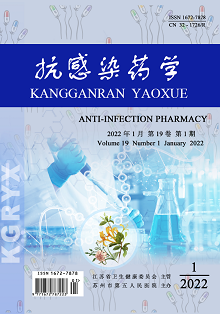SONG Guang-bo, LIAO Wei, NAN Li, GE Ting, SUN Zheng-min, SONG Yu-juan
Objective: To investigate the distribution and drug resistance rate of common pathogenic bacteria in hospitals from 2019 to 2020, and to provide reference for clinical drug usage. Methods: The results of pathogens' identification and drug sensitivity test were collected from the specimens submitted from each ward of the hospital from 2019 to 2020, and the distribution of pathogenic bacteria and drug resistance of main pathogenic bacteria were analyzed. Results: A total of 9 153 strains of pathogenic bacteria were isolated from the specimens collected from each ward from 2019 to 2020, whose main sources were secretion, mid-stream urine and sputum, including 278 strains of fungi, 2 689 strains of Gram-positive bacteria and 6 186 strains of Gram-negative bacteria. The resistance rates of Dung enterococcus to tetracycline, quinuptine/dapurtine were higher than those of Excrement enterococcus. The resistance rates of Excrement enterococcus to streptomycin, levofloxacin, moxifloxacin, ampicillin, penicillin were higher than those of Dung enterococcus. The resistance rates of Staphylococcus aureus to tetracycline, gentamycin and levofloxacin were higher than those of coagulase negative Staphylococcus, Enterococcus faecalis and Enterococcus faecium were 100.00% sensitive to vancomycin and linezolid, coagulase negative Staphylococcus and Staphylococcus aureus were 100.00% sensitive to vancomycin, linezolid and quinuptin/damuputin. The drug resistance rates of Acinetobacter baumannii to furantoin and cefazolin were 100.00%, and its drug resistance rates to gentamicin, imipenem, cefotetan, ceftazidime, ceftriaxone, ampicillin-sulbactam sodium were more than 80.00%. The drug resistance rates of Escherichia coli to cefazolin, ticarcillin and piperacillin were 100.00%, and its drug resistance rates to compound sulfamethoxazole, levofloxacin, ceftriaxone and ampicillin - sulbactam sodium were more than 60.00%. The drug resistance rates of Klebsiella pneumoniae to cefazolin and ticarcillin were 100.00%, and its drug resistance rates to minocycline, compound sulfamethoxazole, levofloxacin, furantoin, gentamicin, ceftazidime, ceftriaxone, ampicillin - sulbactam sodium were more than 60.00%. The drug resistance rates of Pseudomonas aeruginosa to compound sulfamethoxazole, tigecycline, cefazolin, amoxicillin-clavulanate potassium, ampicillin/sulbactam, ticarcillin and piperacillin were 100.00%, and its drug resistance rates to minocycline, nitrofurantoin and cefotetan were all more than 90.00%. Conclusion: From 2019 to 2020, the common pathogens with high proportion in hospitals are fungi such as Candida albicans, Gram-positive bacteria such as Enterococcus faecalis, Enterococcus faecium, coagulase negative Staphylococcus and Staphylococcus aureus, Gram-negative bacteria such as Acinetobacter baumannii, Escherichia coli, Klebsiella pneumoniae and Pseudomonas aeruginosa. Among them, the drug resistance rates of Escherichia coli, Acinetobacter baumannii and Klebsiella pneumoniae show an increasing trend year by year. Therefore, the hospital infection department and microbiology room should regularly monitor the drug resistance rate of various pathogenic bacteria to provide the most reasonable antibacterial treatment plan for clinic.
